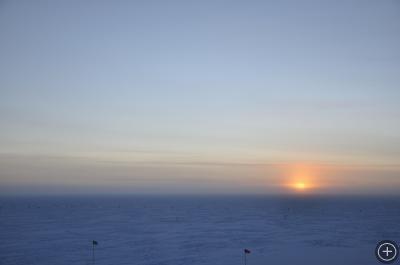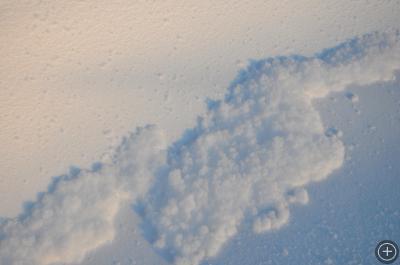Sunset at the South Pole…Finally
SOUTH POLE, ANTARCTICA– Time does pass quickly down here at the South Pole. I’ve been at the Pole for five months now (it’s hard to believe), and I have another seven or so left to go. Having the sun circle around you for the whole summer almost makes the actual sunset seem to come in slow motion. Fortunately we had a little bit of clear sky to view the sun, but there always seems to be a haze on the horizon. Because of the refractive properties of the atmosphere, we can actually see the sun for several days after the official time of sunset.
Soon we will begin covering up all the windows on station and other buildings. At the South Pole, there is a Dark Sector where there is extremely light sensitive equipment and can be affected by any stray light coming though windows from the station. Not to mention it is a distraction from the beautiful night skies (or so I hear from winter-over veterans). We also have the flaglines that mark the path out to any of the outlying science buildings set up. They will come in handy when visibility is poor in the dark of winter. It is still in the dusk stage right now so we aren’t seeing any stars or auroras yet. Apparently by the second week in April is when it gets dark enough. I can’t wait to take some pictures! Camera batteries last only 5-10 minutes when it gets really cold and windy here so I’m going to have to make some kind of insulated housing for it pretty soon.
We’ve now fired up the TV series Battlestar Galactica (on Blu-Ray HD!). I had heard good things about it so I bought it last summer (northern hemisphere) thinking I could use a good TV series to get into for the winter. So far it’s keeping us entertained. I do a Thursday showing of three episodes every week to try to make it last through the winter. It’s tough to stop at three! Most of the weeks lately have involved me lifting weights before dinner, and then either playing volleyball, video games, watching Battlestar, or some other TV show/movie. Things are quite routine around here.
We’ve had a lot of windy conditions lately resulting in large drifts right smack in front of the stairs up to the Atmospheric Research Observatory (ARO). I’m sure we’ll be fighting these all winter as they get worse. ARO was built so that it could be raised as the snow drifts build up. It is in major need of being either raised or dug out completely. Hopefully this gets done next summer. It looks like it will be somewhat of a project because all of our instrument and inlet lines heading out in different directions and will have to be dealt with. Hopefully it’s with minimal downtime for the instruments. The wind has also carved out a lot of sastrugi that are wave like features on the surface of the snow. We use to have a nice waking path from the station to ARO but now it’s bumpy. Once it gets pitch dark, I’m sure I’ll be tripping and falling all the time on my walks to and from ARO. I already did just the other day!
Just the other day, we had the cold weather phenomenon of yukimarimos form on the surface. They would all collect in the pits of drifts and sastrugi creating a cluster of little cotton like balls of ice. They are very strange. They almost remind me of the seeds that come from cottonwood trees that drift around.















Loved the pictures and can’t wait to read more!
Your photography is amazing – I can just envision the little “cotton balls” of ice on the snow – “yukomarimos” – another new word [and phenomenon] for me to research – first, it was the sastrugi, now I want to learn all about the yukomarimos. Thank you for introducing me to more that our world has to offer.
Hi Nick! Watching the sun set and remembering your earlier posts about climbing the tower, etc; do you do the daily measurements and observations alone or do you have a buddy along?
Hi Mark,
Most of the instruments are pretty automated in collecting their data. There are just some daily checks on them to make sure that they are running correct. Johan Booth is my partner out at ARO and we kind of split up duties. For instance he does most of the ozone stuff like launching balloons and taking dobson measurements. I take care of the flask sampling.
Nick